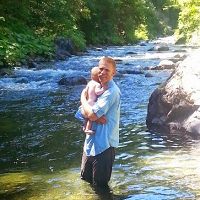Rossi, 2020
Food, Phenology, and Flow—How Prey Phenology and Streamflow Dynamics Affect the Behavior, Ecology, and Recovery of Pacific Salmon
Rossi, G.J. (2020)
University of California, Berkeley
-
Eel, INVESTIGATOR
Abstract
Pacific salmon (Oncorhynchus) are an iconic genus of anadromous fish whose decline over the
last century has linked indigenous peoples, government agencies, fishers, advocates, and
scientists in the common, albeit messy, cause of salmon recovery. While the history of ecology,
and the earliest research on Pacific salmon, is grounded in the understanding that food web and
prey dynamics control the abundance and distribution of predators, the last half-century of
salmon management has focused primarily on hatchery production and physical habitat
suitability. The continued decline of Pacific salmon, after decades of efforts to restore them, has
prompted salmon ecologists to remember what Charles Elton (1927) understood nearly a century
ago: “Food is the burning question in animal society, and the whole structure and activities of
the community are dependent upon questions of food-supply.” My dissertation proceeds from the
observation that both salmon management and salmon ecology have placed too little emphasis
on aquatic food webs, animal behavior, and biotic interactions as key drivers of salmon
production and resilience—and thus as chief mechanisms of salmon recovery.
This dissertation is comprised of a series of studies and experiments from 2016 to 2019, which
explore how the seasonal interaction among physical habitat, phenology of salmon prey, and
foraging behavior affects juvenile salmon growth and performance. The experiments described
here take place near the southern end of the range of Pacific salmon—in Mediterranean streams
along the Pacific Coast of California. These streams experience a characteristic recession of
streamflow between spring and fall, which is an ideal natural gradient to investigate the dynamic
interaction between physical habitat and prey phenology. The studies described here also focus
on one species of Pacific salmon—Oncorhynchus mykiss (the “steelhead” or “rainbow trout”).
that occupy higher velocity habitat than other salmonids. Yet their persistence in Mediterranean
coastal streams with seasonally low velocity and drift suggests an underappreciated flexibility in
foraging behavior. Using novel 3-D videogrammetry along with measurements of invertebrate
drift and stream hydraulics, I quantified the seasonality of foraging behaviors that O. mykiss
employ during the spring-summer flow recession. I also explored the factors that trigger of
foraging mode shifts, which are important for both ecological interactions and salmon
management. I found that 80% of O. mykiss were drift foraging in May, 2018; while over 70%
univariate predictor, the top-ranked statistical models of foraging mode included both hydraulic
variables and drift concentration. This study revealed that O. mykiss in Mediterranean streams
express more diverse foraging behavior than previously suggested in the literature, and that
changes in foraging mode could be predicted by simple hydraulic indicators. This study also
flow enhancement. I found that elevating mid-summer baseflow for one week caused significant
increases in dissolved oxygen, riffle width, depth, velocity, invertebrate drift, and benthic
invertebrate standing crop – and these changes were evident at sites more than 1 km downstream
from the point of flow augmentation. I also documented consistent behavioral changes indicating
that pool-dwelling salmonids were able to exploit the increased prey abundance and improved
metabolic environment in the treatment reach after flow augmentation. Counts of foraging
salmonids near riffle-pool transition zones doubled, foraging movement remained steady
(relative to decreasing movement in the control reach), and the proportion of drift foraging
salmonids increased from an average of 26% to an average of 77% after augmentation.
Collectively, these results suggest that dry season flow enhancement can significantly improve
habitat profitability for salmonids, but that the timing and location of flow augmentation, relative
to downstream points of interest, are critical to meeting ecological objectives.
production interact to affect foraging profitability for juvenile salmon during the streamflow
recession in Mediterranean coastal streams. I evaluated the model by comparing two distinct
salmonid rearing streams—one perennial, cool, and shaded; the other intermittent, seasonally
warm, and sunny. In both streams, I conducted a photon-to-salmon food web study to document
the seasonality of hydraulic habitat relative to the phenology of prey biomass for O. mykiss. I
also estimated the seasonal change in O. mykiss growth potential using a drift foraging
bioenergetics model. Both streams offered profitable foraging opportunities for O. mykiss, but
modeled growth potential peaked at least two months earlier in the intermittent stream, where
lipid storage measured in mid-July was nearly twice as high. In contrast, modeled and measured
early-summer growth was higher in the perennial stream. By late summer, foraging profitability
declined in both streams. However, abiotic conditions approached lethal tolerance levels in the
intermittent stream, whereas the perennial stream maintained suitable abiotic conditions all
summer. Seasonal changes in growth potential were explained by the timing of streamflow
recession relative to the phenology of prey fluxes. But ecological interactions (especially
intraspecific competition) and flexible foraging behavior both appear to have mediated realized
foraging opportunity. These observations lead me to speculate that juvenile O. mykiss life
histories should differ among streams, due to the timing of their spring-summer growth potential
and to differing late summer survival rates. Collectively, these stream types could contribute to a
stabilizing portfolio of juvenile salmonid life histories.
Citation
Rossi, G.J. (2020): Food, Phenology, and Flow—How Prey Phenology and Streamflow Dynamics Affect the Behavior, Ecology, and Recovery of Pacific Salmon. University of California, Berkeley.
 This Paper/Book acknowledges NSF CZO grant support.
This Paper/Book acknowledges NSF CZO grant support.
Explore Further

